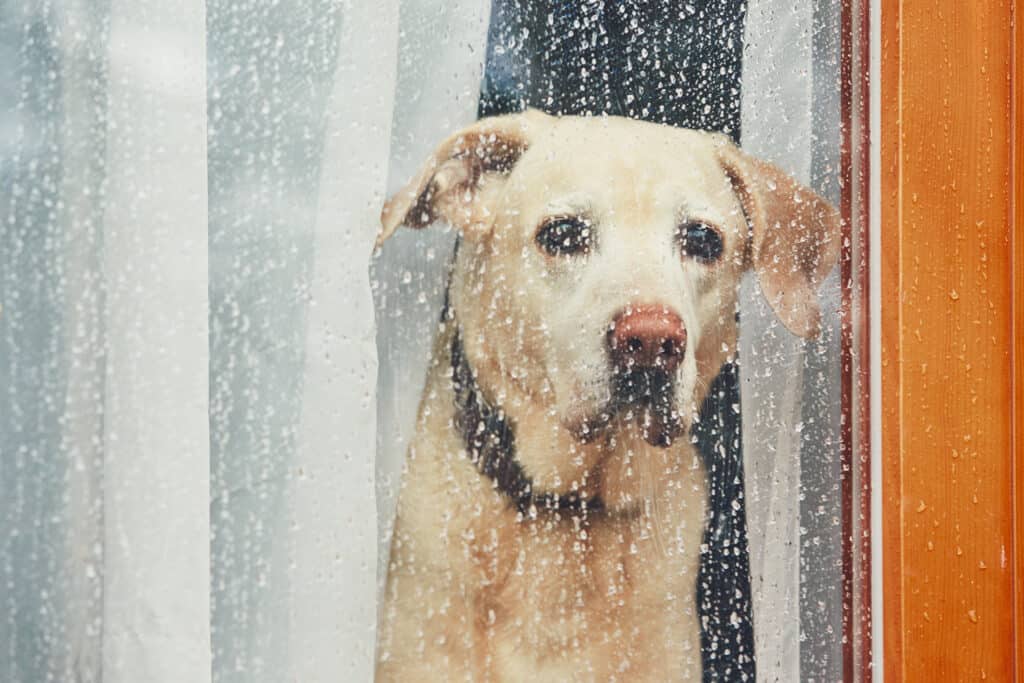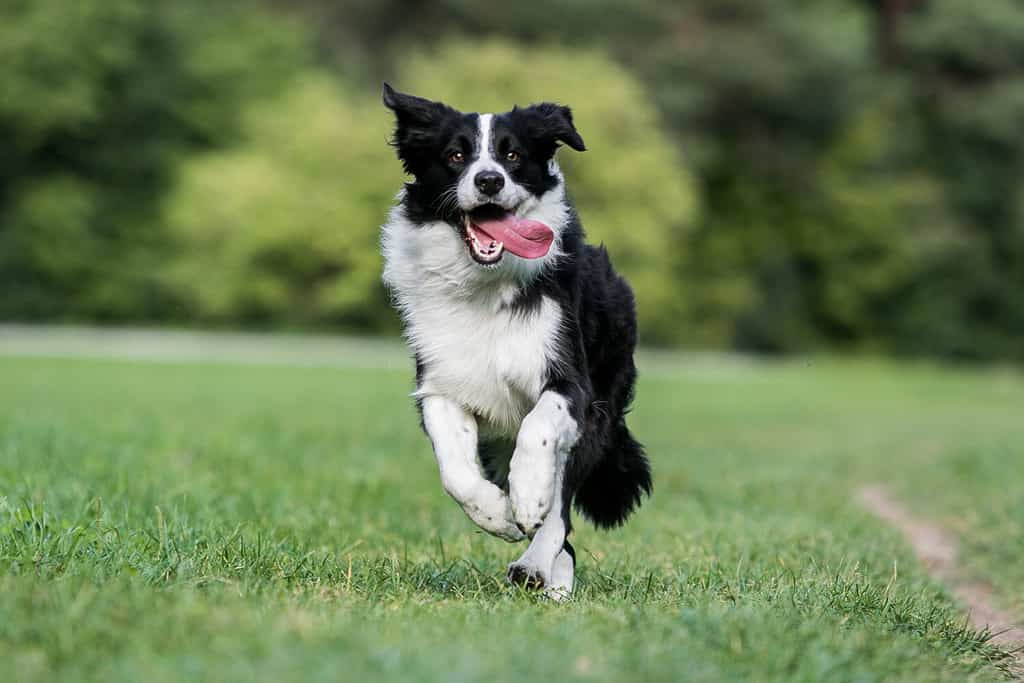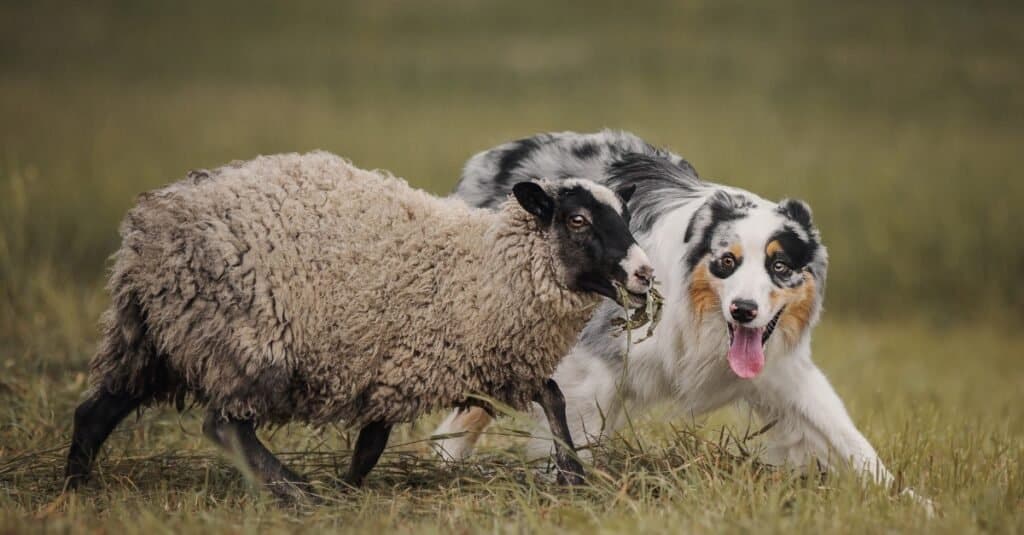All dogs love to be in the company of their owners, but some dogs require more quality time than others. While separation anxiety is not exclusive to certain breeds, some breeds struggle more with being alone than others.
Let’s talk about why some dogs have a hard time being alone, and which dog breeds struggle the most!
Why Some Dogs Struggle with Being Left Alone

Separation anxiety in dogs can develop due to a change in routine, loss of an owner, or loud noises.
©Jaromir Chalabala/Shutterstock.com
Let’s first break down why some canine friends struggle so much with being alone.
Lack Of Exercise & Stimulation
Some dogs struggle with being left alone due to not having enough opportunities to expel their high energy levels. A dog with a lot of energy will need plenty of daily exercise to help him feel fulfilled. If dogs are not getting enough physical stimulation each day, they may begin to act out when they are alone. A dog that does not get enough exercise may struggle with excessive howling, destructive behaviors, and difficulty being left alone.
Most dogs need a minimum of 30 minutes of daily exercise. This can be anything from long walks to a game of fetch.
Separation Anxiety
Some dogs that struggle with being left alone may also suffer from separation anxiety. Separation anxiety can be more prevalent in certain breeds. However, a variety of factors can lead to the development of behavioral issues with separation. This can include sudden loss of an owner, a change in normal schedule, loud noises, and even an unstable past.
10 Worst Dog Breeds to Be Left Alone
Let’s introduce the 10 breeds that have a hard time with being left alone for long periods.
1. Border Collie

The
border collie
is known to have an incredible amount of energy.
©Aneta Jungerova/Shutterstock.com
The border collie is known to have an incredible amount of energy. Their high energy levels require plenty of daily exercise. They are also more prone to struggle with intense boredom when alone. This can often lead to destructive behavior and excessive barking. Offering these pups at least 45 minutes of daily exercise can help decrease behavioral struggles. Additionally try to spend quality time with your border collie each day.
2. German Shepherd

German shepherds are smart, loyal, and energetic dogs.
©Schelmanova Natalia/Shutterstock.com
Similar to the border collie, the German shepherd is considered high energy. Not only do they have high exercise requirements, but they are also highly intelligent. This combination can lead to increased risks of boredom and separation anxiety when they are left alone. German shepherd’s with separation anxiety can struggle with destructive behaviors, excessive barking, and even aggression. Most German shepherds need at least 45 minutes of daily exercise, as well as quality time with their owners.
3. Australian Shepherd

If Aussies do not get enough exercise, they can suffer from separation anxiety and destructive behaviors.
©iStock.com/Julia_Siomuha
The Australian shepherd is on a whole new level of energy. Most Aussies are known to bounce of the wall with energy. If they do not get enough daily exercise, they can suffer from severe separation anxiety and destructive behaviors. Offer your Aussie at least an hour of daily exercise, and spending quality time with her each day.
4. Siberian Husky

Siberian
huskies can struggle with excessive howling when they are left alone.
©Ksenia Raykova/Shutterstock.com
The last high energy pup on the list is the Siberian husky. Not only does the Siberian husky have a lot of energy, but they become extremely attached to their owners. When left alone for extended periods, the Siberian husky is prone to excessive howling and destructive behaviors. Siberian huskies need an hour of exercise each day, as well as plenty of quality time with their owners.
5. Italian Greyhound

Italian greyhounds form close bonds with their family.
©Lenkadan/Shutterstock.com
The Italian greyhound is a wonderful companion. They form close bonds with their family, and they enjoy nothing more than spending quality time with those they love. With this closeness comes an increased risk of separation anxiety and difficulties with being left alone. This can often lead to destructive behavior and accidents around the house. We suggest taking your Italian greyhound on 15–20-minute walks before leaving him alone. Spend plenty of time with him as well.
6. Havanese

The
Havanese
was bred specifically to be a lap dog and companion.
©Dorottya Mathe/Shutterstock.com
The Havanese was bred specifically to be a lap dog and companion. They form close bonds with their owners for this reason, so they often struggle with being left alone. This can often lead to destructive behavior and accidents around the house. Take your Havanese on 15-20-minute walks before time spent alone, and spend plenty of time with her when home.
7. Toy Poodle

The
toy poodle
is incredibly affectionate, kind-natured, and loving.
©Lim Tiaw Leong/Shutterstock.com
The toy poodle is incredibly affectionate, kind-natured, and loving. They often become dependent on the presence of their owners due to the close bonds they form. They struggle with separation anxiety in many cases. A 15-to-20-minute walk will help your toy poodle cope with alone time. Spending plenty of quality time with him helps too.
8. Maltese

The Maltese wants to be with their owners at all times.
©Tomsickova Tatyana/Shutterstock.com
The Maltese is another canine friend on this list that was bred specifically for being a companion. They like being in their owner’s lap as often as possible. It is difficult for them to be alone for long periods. Treat your Maltese to a 15-minute walk before leaving for the day and spend some quality time with him as well.
9. Chihuahua

Chihuahuas are used to being treated more like children than tiny pups.
©ElenaYakimova/Shutterstock.com
A Chihuahua wants to be attached to his owner’s hip at all times. They are used to being treated more like children than tiny pups. They struggle when separated from their owners for long periods. Chihuahuas with separation anxiety can struggle with excessive barking, destructive behaviors, and accidents around the house. Chihuahuas benefit from a 15-minute walk before alone time. When at the house with your pup, offer him quality time playing and snuggling.
10. French Bulldog

French bulldogs love being around people!
©Yuliia Kyrylius/Shutterstock.com
The French bulldog is known for being addicted to spending time with people. They love being in the presence of those they love, and they often struggle when on their own. They can display destructive behaviors when they are alone, but they are most known for their excessive howling. We suggest taking your French bulldog on a 20-minute walk before taking off. Give her plenty of quality time with you during down time.
How Long Can I Leave My Dog Alone?
Many of us would love to spend each second with our canines. However, this isn’t possible for most pet owners. Most of us need to leave our homes to go to work and run errands, so our little ones need to be left alone at some point.
Ideally, you should avoid leaving your dog alone at home for more than six hours. If you do have to leave your pup alone for more than six hours, then we suggest having someone take your little one on a quick walk. This is especially important for the small dogs on our list, as they have a hard time holding their bladders for extended periods.
There are a few things you can do if you know you will need to leave your dog at home alone for longer than usual. We suggest taking him on a long walk before you leave, making sure he is well fed, and making sure he has some form of entertainment. Asking a friend to stop by and walk him after the six-hour mark is also ideal.
The photo featured at the top of this post is © GoodFocused/Shutterstock.com
Ready to discover the top 10 cutest dog breeds in the entire world?
How about the fastest dogs, the largest dogs and those that are -- quite frankly -- just the kindest dogs on the planet? Each day, AZ Animals sends out lists just like this to our thousands of email subscribers. And the best part? It's FREE. Join today by entering your email below.
Thank you for reading! Have some feedback for us? Contact the AZ Animals editorial team.







